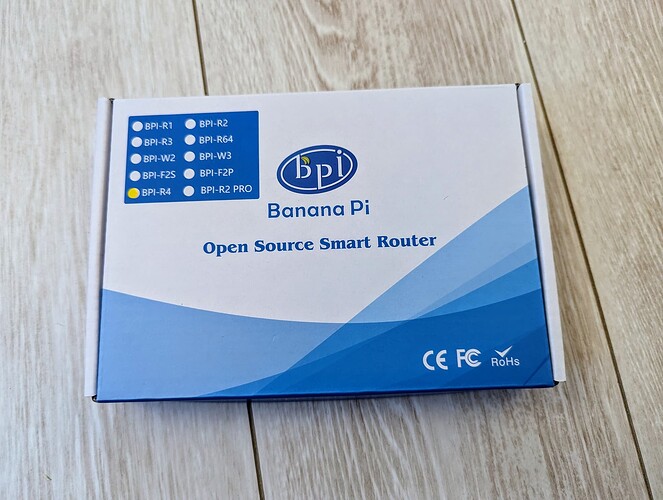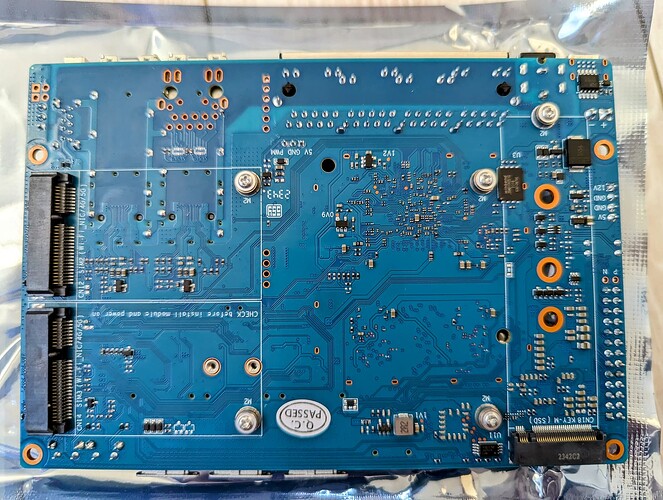What are people using as heatsink (passive I pray) and case?
Seems like a regression by Sinovoip. The Banana Pi R3 has holes for mounting a heatsink/fan, but they appear to have missed that with this device.
Seems like a regression by Sinovoip. The Banana Pi R3 has holes for mounting a heatsink/fan, but they appear to have missed that with this device.
Seems like - doubt it can work without any heatsink at all? So how are we supposed to cool it? Case with fins and special copper block like the fanless mini PCs?
Shame really, would be almost ideal for my use case (passively cooled 10G fiber router to get away from the weirdness that is routeros 7).
There is a fan connector, I guess we have to use a fan with heatsink.
Wouldn't be the first device were the fan is optional. Or only needed when you use all the options.
I literally only need the two SFP+ (fiber optics and DAC to a switch, so no power hungry 10G copper)
Does anybody know what node the filogic 880 is made on?
I think it really depends on the CPU power needed, high speed routing will generate more heat.
BTW I just found this from Banana Pi forum:
Supposedly 10G NAT can be done in hardware so maybe not all that power-hungry.
I saw those sketches (and the fan) but to me it doesn't really answer the question of how the heatsink is attached. Seems like there is also some shim?
In the photo of the actual device above there appear to be two holes for mounting a heat sink. One is near the "5V GND PWM" marking on the back and the second is to the left of the first hole for securing M.2 device. From the top side one is to the right of the FAN connector and the second to the right of the U02 memory IC. Just measure the distance and you should be able to find compatible heat sink.
Sorry, hard to tell from the photo, are the SFP cages empty?
To confirm, these are SFP+ and not SFP cages?
So SFP GPON modules like https://www.fs.com/products/183843.html?attribute=92369&id=3301112 and https://de.aliexpress.com/item/1005003515662920.html will not work?
Which is a shame as I was hoping the CPU on the R4 would defo let me SQM traffic at 1 Gbps.
Is the BPi R3 the better choice to use with the optics above?
All interface modes (1000BaseX, 2500BaseX, Cisco SGMII) supported by the R3 are also supported by the R4.
In terms of SFP modules except for some modules which will not work for electric reasons they should all be fine (like the TP-LINK TL-SM410U 2.5G copper module which doesn't pull Moddef0 to ground and hence doesn't get powered by the R4, while it works fine with the R3).
more than that even 100MBit transceiver should work, jutr try it.
Hi all.
Is this something to worry about (my speed is only 2.5G for now) ?
1. 10G SFP Module
The SFP serdes speed of BPI-R4 is fixed at 10Gbps, so only SFP that support this can be used!
Usually the PIN6 of 10G SFP+ module is GND. After inserting the module, SFP_MOD_DEF0 will be pulled low, thereby turning on the SFP power supply.
Therefore, if this PIN of the module is not GND, 3.3V_SFP power will not be supplied!
This only applies to SinoVoip's stock firmware. With the upcoming support in vanilla OpenWrt, also SFP modules with lower speeds will work.
It's their current firmware limitation, and this applies to fiber module only
Thanks for the clarification. Makes sense. I couldn't figure out how they managed to design a board with a problem like that ![]()
Reading hardware specs is hard when they mix software bugs into it.
So the manufacturer only produced the board, and then used whatever they can think of to make the board working as a prototype, kind of a "proof of concept", to let customers know about new product, so they don't care software is scalable or not.
Mediatek here is going the correct way, which is actively involving in upstreaming their device to linux mainline kernel, before that you'll see lots of different issues happening, which is kind of expected.
hi! do you have any measurement of the idle power consumption? thanks!



